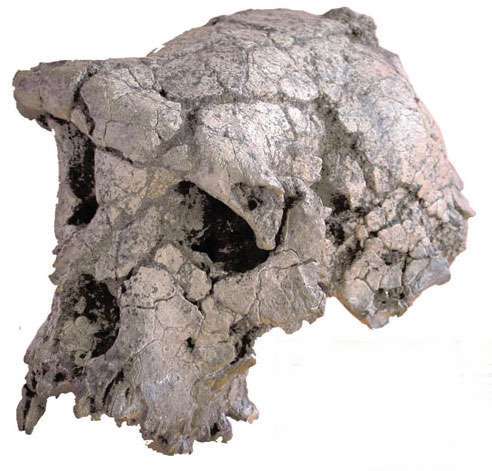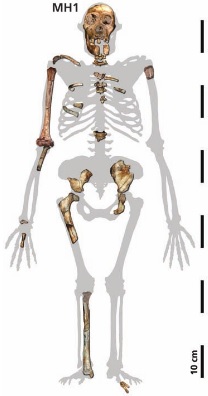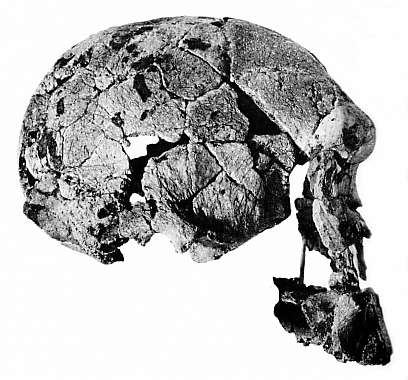- [Sections]
- [Categories]
- [Stories]
- [Articles]
-
[Papers]
&“In the Crosshatch” &“Out of the Broom Closet” &“Encountering Yahoocentrism” &“Beowulf: A Primordial Horror” &“How Urbanization has Changed Us” &“Through a Glass, Darkly” &“Fear of the Feminine” &“Mitochondrigeny” &“Putting Humans in Their Place” &“From Progressive Evolution to Opportunistic Evolution”
- [About]
- [The Hominid Homepage]

[Last Update: June 6th, 2018] Contents
TM 266-01-060-1 ARA-VP-6/500 BOU-VP-11/1 & 12/1 KNM-ER 20419 AL 288-1 KNM-WT 40000 Taung 1 Sts 5 Stw 431 MH1 KNM-ER 3735 KNM-ER 1813 KNM-ER 1470 KNM-WT 15000 Trinil 2

|
D. Jon Scott’s Website ► Science ► Physics ► Chemistry ► Organic Chemistry ► Biology ► Eukaryology ► Zoology ► Ichthyology ► Herpetology ► Mammalogy ► Primatology ► AnthropologyFossil Hominid SpecimensThe Bare-Bones Evidence.Copyright İ 2017 by Dustin Jon Scott
|
|
Toros-Menalia specimen 266-01-060-1 (TM 266-01-060-1), or “Tomai”
Classification Sahelanthropus tchadensis Homo tchadensis |
ARA-VP-6/500
|
Aramis Vertebrate Paleontology specimen 6/500 (ARA-VP-6/500), or “Ardi”
Classification
|
KNM-ER 20419
|
Kenya National Museum, East Rudolf specimen 20419 (KNM-ER 20419)
Classification Australopithecus anamensis Prĉanthropus anamensis Homo anamensis, Homo africanus anamensis, or Homo afarensis anamensis |
AL 288-1
|
Afar Locality specimen 288-1 (AL 288-1), or “Lucy”
Classification
|
KNM-WT 40000
|
Kenya National Museum, West Turkana specimen 40000 (KNM-WT 40000)
Classification Kenyanthropus platyops Australopithecus platyops Prĉanthropus platyops Homo platyops Prĉanthropus africanus platyops Homo afarensis Homo africanus afarensis |
Taung 1
|
Taung specimen 1 (Taung 1), or “The Taung Child”
Classification
|
Sts 5
|
Sterkfontein specimen 5 (Sts 5), or “Mrs. Ples”
Classification
|
Stw 431
|
Sterkfontein specimen 431 (Stw 431)
Classification
|
BOU-VP-11/1 & BOU-VP-12/1
|
Bouri Vertebrate Palaeontology specimens 11/1 and 12/1 (BOU-VP-11/1 & BOU-VP-12/1)
Bouri skeleton, BOU-VP 12/1 “The humerofemoral index of BOU-VP-12/1 differs significantly from both OH 62 and AL 288-1, but not from KNM-WT 15000. Published length estimates, if correct, suggest that the relative forearm length of BOU-VP-12/1 is unique among hominins, exceeding those of the African apes and resembling the proportions in Pongo.” Classification Australopithecus garhi Homo garhi or Homo africanus garhi |
MH1
|
Malapa Hominid specimen 1 (MH1)
Classification Australopithecus sediba Under classification schemes which merge Pan with Homo, Australopithecus sediba becomes Homo sediba or Homo africanus sediba |
OH 62
Olduvai Hominid specimen 62 (OH 62), or “Dik-dik hominid”
“Although the difference in humerofemoral proportions between OH 62 and AL 288-1 does not exceed variation in the extant samples, it is rare. When humerofemoral midshaft circumferences are compared, the difference between OH 62 and AL 288-1 is fairly common in extant species. This, in combination with error associated with the limb lengths estimates, suggests that it may be premature to consider H. (or Australopithecus) habilis as having more apelike limb proportions than those in A. afarensis.” “The humerus and femur of the fossil hominid OH 62 are badly damaged and their lengths are not directly measurable (Johanson et al., 1987). Nevertheless, using relatively intact reference materials from another early hominid, AL 288-1, Johanson et al. (1987) reconstructed the bones to estimate the humerofemoral index, which falls well above the range for modern Homo, above the estimate for AL 288-1, and within the range for Pan paniscus. The reconstruction of missing bone by the method originally employed for OH 62 is broadly reproducible in a representative modern sample of Homo, making possible the estimation of an associated error term intrinsic to this method. Using the approximate variance of the ratio mean (Kish, 1965), shown here to be a good estimator of the sample variance of the humerofemoral index, the analysis of this modern sample extrapolated to other living hominoids gives quite acceptable results. Applied to OH 62, it suggests an error term associated with the estimated humerofemoral index so substantial that it is only possible to situate the index somewhere between the distributions for Homo and Gorilla, and quite possibly not above the index for AL 288-1. On the other hand, the predicted distribution for the humerofemoral index of AL 288-1 is more securely placed between the distributions for Homo and Pan paniscus.” Classification Homo habilis Australopithecus habilis Under classification schemes which merge Pan with Homo, Australopithecus habilis reverts back to Homo habilis, unless the various species within genus Australopithecus are re-analyzed as subspecies of Homo africanus, in which case Australopithecus habilis becomes Homo africanus habilis |
KNM-ER 3735
| Kenya National Museum, East Rudolf specimen 3735 (KNM-ER 3735) |
KNM-ER 1470
|
Kenya National Museum, East (Lake) Rudolf specimen 1470 (KNM-ER 1470)
Classification Homo habilis Homo rudolfensis Homo africanus rudolfensis Homo africanus habilis Australopithecus rudolfensis Australopithecus habilis rudolfensis |
KNM-ER 1813
|
Kenya National Museum, East (Lake) Rudolf specimen 1813 (KNM-ER 1813)
Classification Homo habilis Australopithecus habilis Australopithecus habilis habilis Homo africanus habilis |
KNM-WT 15000
|
Kenya National Museum, West (Lake) Turkana specimen 15000 (KNM-WT 15000), also known as “Nariokotome Boy” or “Turkana Boy”
Classification Homo erectus Homo ergaster Homo sapiens erectus |
Trinil 2
|
Trinil specimen 2 (Trinil 2), or “Java Man”
Classification Homo erectus & Homo erectus erectus Homo sapiens erectus |
















